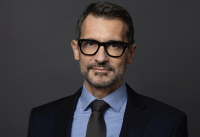
Verena Ross, chairperson of the European Securities and Markets Authority, Esma, spoke to Investment Officer about creating a single supervisory body for multinational investment firms, the lack of transparency in private markets, the new Eltifs, the need for investor education, and about building a collaborative, efficient and high-quality supervisory framework in Europe.
She was appointed to this role, and confirmed by the European Parliament, in 2021 for a five-year term that can be renewed once. The interview took place in Luxembourg on the sidelines of an institutional investor conference hosted by the European Commission, the European Investment Bank, EIB, and the European Stability Mechanism, ESM.
IO: Nicolai Tangen, chief executive of Norway’s 1,600 billion dollar oil fund, recently expressed concerns about investing in Europe, highlighting the vast outperformance of US shares in the past decade and criticising the mindset in Europe, in terms of acceptance of mistakes and risks. What do you think when you hear comments like that?
Verena Ross: “I personally find it disappointing that we as Europe can’t offer sufficiently attractive propositions, that our biggest national professional investors have to go outside of Europe to find the investment opportunities that they are looking for. We, in Europe, have a lot of innovative companies, growing companies that need funding and capital, and are looking for these type of cornerstone investors to support them in their development journey. And, for some reason, our market ecosystem is not well adapted to serve those companies and bring the professional investors and the retail investors through broader capital funding pools, together with those companies to try to find the right solutions.”
IO: It’s a challenge that Europe has identified already ten years ago, when we started looking at Capital Markets Union. That was a challenging project, with people saying, well, it has failed. We had the Letta report out just last month, and back into European history, we had the ambition of the Lisbon Agenda, making Europe the most competitive economy in 2020, which also failed to materialise. Is Europe at a standstill? Or do you see signs of progress?
VR: “First of all, I think you need to take a more nuanced view. There have been two action plans for Capital Markets Union. It’s very easy to just say that nothing has happened. I think that’s not true. There have been steps that have been taken which have been important to try to assist the European capital markets to continue to develop and grow. At the same time some of those measures still need to be implemented. We should not forget about that as well, things like consolidated tapes,like the European single access point for company information, all of that still needs to be implemented. And let’s hope it actually will allow us to make another step forward. After all, for example, in the United States, consolidated tapes have existed for a long time, and they have helped to create more of a single liquidity pool, better transparency across the market. So I would not completely dismiss what is happening. At the same time, if you look at the outcome, clearly we are not where we want to be. And we need to really now look holistically at how can we break down barriers that are still existing within the European Union. We don’t have the single market for capital. We have some steps towards a single market, but we’re not there yet. And also, how can we make sure that we make Europe an attractive proposition for investors and for companies that really is, in an open way, creating a European capital market that can work for everyone.”
IO: ESMA has tabled 20 points, suggestions for improvement. We’ve also seen the Letta report for Capital Markets Union version two. Do you think we should still call it Capital Markets Union?
VR: “I think the name, in the end, is not the important thing. For me, the important thing is, what are we trying to achieve, what is the aim? And that is a single European capital market that builds on a combination of national initiatives and strengths the equity and capital market possibilities at national level, at regional level, but also interconnects all these efforts in a way that we actually build the scale and capacity at a European level. Because we also need to recognise that, while it’s important to encourage more capital market investment and more long-term equity possibilities in each member state and regionally, we will never succeed if we don’t bring it together in a genuinely European context.”
IO: Out of the 20 points that you’ve listed, which one has your gut feeling as being the most promising one?
VR: “It’s hard to choose anyone, because we deliberately wanted to take that holistic approach. There’s not one thing that is a magic wand with which you suddenly create this successful and effective European capital market, therefore, we try to point to what we see as key priorities, but also balance it with some recommendations that are clearly more urgent, maybe a bit easier to deal with. Some things take longer.Let me just take a couple of examples. Investor Education and Literacy is clearly a very important long term goal, but is something that will take a lot of time. It is really down to national educational systems and so on., It’s very important, but it’s also something we are not going to be able to shift very quickly. While, for example, breaking down some of the barriers for creating more Pan European market segments, allowing liquidity pools to talk to each other, and facilitating some of the fragmentation in the post infrastructure space, are things that are also not easy, but at least you could think about how you could take steps in the short/medium term. Looking at the securitization market, is something where there seems to be a lot of political attention. I also see some possibilities to make some steps more quickly in this area. But for us, if you look at what’s really important, it’s the mix of making sure that there are more simple, basic investment opportunities for citizens, for investors. Part of that is also looking at the pension systems, at the ability to have tax efficient savings accounts, those types of things which very much need the combined focus of the national initiatives and the European focus to make them work. That to us, is one of the core recommendations.”
IO: You mentioned the liquidity pools. Can you elaborate on that idea?
VR: “One of the things that we have started talking about, but we have not put very concrete proposals forward, is to create, for example, specific market segments that might help to create an ecosystem around certain European sectors or companies, for example certain SMEs. We’ve seen, for example, in certain regional and national markets that they have been quite effective in attracting equity capital and listed companies around certain specialised subject matters, just because the investor base knows those type of companies. They are willing to support as cornerstone investors. We’ve seen that quite successfully in some of the Nordic markets. Euronext Oslo, for example, has been quite successful in attracting fishing and shipping companies, just because there’s a certain specialisation. You can create genuine cross border, European, specialised, Pan European segments that might actually be quite effective in creating that link between the investors and the companies.”
IO: Does Luxembourg come to mind when you think about these liquidity pools?
VR: “Luxembourg clearly has a very strong position when it comes to the fund management industry. And I think one of the things we’ve also emphasised is this is not just about public equity markets, which clearly we want to foster because we believe transparent equity trading on an exchange is important. And actually Luxembourg on the corporate bond market is a very strong player. But we want to also look at the private funding possibilities through private equity, through venture capital, which need to complement the different funding sources that companies need in their lifetime. In my speech here in Luxembourg I talked a lot about that, about how we can make sure that we also create the right environment to bring private funding sources to companies. Companies, particularly in their growth paths, need different funding sources at different parts of their lifecycle.”
IO: How much do you expect from Eltifs?
VR: “I think Eltifs is a very promising market framework that focuses on long term investment products, which is clearly something that Europe needs. Therefore we believe it’s an important framework. We hear a lot of market interest in the framework. So hopefully this will be one of the areas where we can see growth over the coming years.”
IO: The Dutch state pension funds, for example, are discouraged, actually, to go into private equity, because the costs are so significant. Don’t these costs make it a bit of a difficult premise for the private investors that are asked to step into this market?
VR: “one of the things we need to look at is the right mix, you know. There’s also the issue of how to make sure that the more institutional investors, pension funds, insurance companies, see the value of investing in some of these long term possibilities in Europe. Obviously, costs and fees is one aspect of that. I think it’s a challenge also when it comes to attracting retail investors. The industry needs to find the right mix of cost and performance that actually allows investors, in the end, to get the returns that they need to make it an attractive proposition.“
IO: Would that be an Esma message to the private markets industry?
VR: “As Esma, we have been working on transparency, disclosure, but also the overall balance of cost and performance for many years. We publish every year a cost and performance report where we compare the cost and performance metrics across the European Union. Clearly, it’s a focus for us to make sure that investors are not only aware, but also take that properly into account in their overall decisions on how to invest. And I think that a combination of investor pressure and an industry that tries to really meet the best interest of the investors in combination, will hopefully get us into a better position over time.”
IO: So Esma is basically asking the industry to provide value for money, even when you provide private sector investments through Eltifs?
VR: “In any area, and I wouldn’t single out any particular part of the sector. I think the issue is that in whatever sector you’re working and where the industry is providing products and services, the cost performance balance needs to be right. In the end, it needs to be in the best interest of whether it’s a retail investor or the professional investor. Of course, the professional investor is in a far better position to negotiate that. Our responsibility, as a regulator and supervisor, is particularly to the retail investor and creating the possibility for retail investors to have the right products that allow them t to make that trade-off, in a way where they can also be supported through possibly voluntary labels or a simplified advice process that is not so expensive, to make it prohibitive, this is something that we obviously point to in our position paper as well.”
IO: Would it be fair to say more needs to be done to boost the representation of the interests of retail investors in Europe, because they are basically left in the hands of the industry? It’s an issue that also relates to the challenges of the European system.
VR: “For Esma, promoting the protection of retail investors and keeping the best interest of retail investors in our mind is one of our core priorities. If you look at our strategy that we published last year, one of our three core priorities is exactly that: promoting and enhancing the protection of retail investors. And part of that is obviously the proper information, the proper support that they can get, but also just, creating an environment where there is just more possibility that the retail investor voice is being heard. In our stakeholder engagement we always try to balance the stakeholder views that we collect, because, of course, retail investors have much less power in presenting some of their views compared to the very heavy industry voice that we always get. It is important to get that balance right. And as regulators and supervisors and I extend that from Esma to the national competent authorities, we’re all very conscious that we need to also support that balance, and in our decision making properly reflect the importance of getting the right outcome for investors, and particularly for retail investors.”
IO: A new EU policy term is about to start now that we’ve had elections. I’d like to explore with you, sort of beyond the horizon, how do you see supervision in the European financial market develop.
VR: “If you look at our priorities for the next five years l, it is very much about retail investor protection, as well as about more effective and stable, and attractive, capital markets in Europe. And the third priority is quality of supervision and enhancing the quality of supervision. That will continue to be very much a joint undertaking, because the vast range of financial market entities will remain, and rightly so, being supervised at national level. We need to continue as Esma to, in that context, make sure that we have strong and effective supervisory convergence, to ensure that we have common supervisory outcomes, and high quality supervision and enforcement of the European regulatory framework and ruleset. But we also believe, and that is also in our position paper, and was supported by the whole of the Esma board, (which, after all, has all the national supervisors around the table) that we should investigate other areas where we actually need to reconsider what’s the most efficient and effective way to supervise, particularly for pan-European market players, market infrastructure players, some of the newer type of market players that are coming into the European Union, where we need to make sure we have no regulatory arbitrage risk. Does it make sense to actually look at supervision at an EU level? And as I said, it will be and remain, very much a kind of “hub-and-spoke” approach, very much looking at the best possible supervisory framework for each individual sector and market. But we can clearly see for some of the pan-European players, EU-level supervision would make sense, because you just create a more efficient and more common cross-European framework that doesn’t just create the common rule book, but also gets to common implementation and supervision on the ground.”
IO: In the banking sector, creating a single European supervisor required a major financial crisis. Do we need another crisis before Europe moves towards a single supervision in financial markets?
VR: “I personally hope that we can get to a more efficient and a good supervisory structure in the European Union in the absence of the financial crisis. As a supervisor, we would prefer to avoid a financial crisis. For us, it is about monitoring the risks and trying to mitigate the risks that could lead us there. I very much hope that with the political will, we can make some progress on EU capital markets in the current environment, without another financial crisis.”
IO: Theoretically speaking, what would a single supervisor for Europe’s markets look like? Is the new constellation of the ECB with the European Banking Authority a model? Could that be replicated to financial markets? Or would Esma become a direct supervisor of the largest entities in the EU?
VR: ”I don’t want to speculate about what potential structures and frameworks could look like. What I would like to say is that Esma has shown already that we are the direct supervisor and exclusive supervisor in the European Union for certain entities. Already, I think we’ve shown that we can be an effective, risk-based, outcome-focused and data-driven supervisor. And therefore, I think we’ve set a good ground for looking at whether there are other areas and sectors where that might make sense. We have seen also that we need to work withthe national supervisors because a lot of the expertise and capacity is there. We need to make sure that we harness that, and that we work closely together. So I think it is very much a joint undertaking. At the same time, by ensuring that we have one single supervisory view, that we move forward in a single and united way, is really how we can make a difference over time and break down some of the barriers that are still there.”
IO: That sounds like Esma could be the European SEC in 2030?
VR: “We need something that works for Europe, and I think we need to recognise that that means we will have to have a different regulatory framework which acknowledges the very important benefit that you have from strong, effective national supervisors, but also from a strong and efficient system that allows European scale in certain areas.”
IO: Your report on greenwashing this week made clear that there are huge discrepancies among national supervisors in terms of capacity, in terms of issuing fines. It relates to the differences in the markets as well, but we’re seeing a huge difference in approaches at different national levels. Is this something that investors should be concerned about?
VR: “The difference in the supervisory capacity is a challenge. What we try to show in the greenwashing report is that all NCAS have started down that route. We as Esma are trying to help build capacity and focus on sustainable disclosures, on sustainability generally, but we are also conscious that this needs capacity building in the industry and in the regulators and supervisors. It is something where we are all on a learning curve. But it’s clear that there are and will be differences just in the capabilities and also financial resources and budget - IT resources and data are very important in this space. As Esma we are trying to help build capacity, look at common ways in which we can maybe collect or bring data together to try to create efficiencies that ultimately allow all of us as supervisors to do more in a more efficient way, by doing it as EU 27 rather than each of us individually trying to build the capacity and resources.”
”The reality is, particularly when it comes to enforcement, a lot of those actions will have to be taken at national level. It is more about trying to drive more common approaches up front that will then allow us to take the common supervisory actions and achieve common outcomes across the European Union.”
Further reading on Investment Officer Luxembourg:
-
Esma faces uphill battle to emerge as European SEC
















